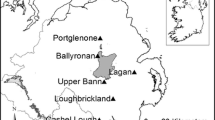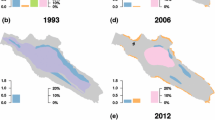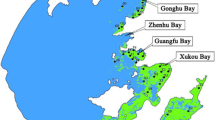Abstract
In mid-2004, anthropogenically induced changes in water quality of the Río Cruces wetland, a Ramsar site located in southern Chile (ca. 40°S), enhanced the resuspension of iron-enriched sediments, which were subsequently deposited over the most abundant aquatic macrophyte of the wetland (Egeria densa Planch. 1849). This event triggered the formation of brownish, necrotic patches and increased iron contents in the leaves and stems of E. densa, which contributed to a significant demise of the plant within the wetland. In this study, we estimate the recovery time as a proxy for resilience of this macrophyte at organismal and population levels. Macro- and micro-optical characteristics, as well as iron contents in tissues of E. densa, were documented in four time windows (2004, 2008, 2012, and 2014). In addition, the size of the macrophyte population and its spatial occurrence were monitored from 2008 to 2016 across 36 study sites within the wetland. Our results suggest necrotic patches and high iron contents in E. densa persisted at least until 2008. After 2013, a significant increase in the spatial occurrence of E. densa was observed within the wetland, reaching full recovery of the population during 2015. The health of plant tissues and iron contents in leaves and stems showed recovery period close to 4 years, while the recovery of the spatial occurrence of E. densa took approximately 9 years. While the monitoring of plant health was not performed on a strict annual basis, the recovery rates estimated here are slower than those described for other macrophytes. This finding might reflect the long-lasting effects of the disturbance from 2004 and the interaction with biotic processes, such as foraging by waterbirds recolonizing the Río Cruces wetland. These results show that full recovery of E. densa was achieved through a cascade of effects starting with abiotic factors (water quality) and passing through physiological and individual levels, to finally reach the population level. A key aspect of this response is the invasive nature of the macrophyte, which likely contributed to its recovery as a consequence of improved water quality. Less successful macrophyte species in other systems may not reach the specific population recovery, and become subdominant species instead, or even be eradicated from the wetland either as the result of herbivory or due to competition with other macrophytes.



Similar content being viewed by others
References
Bakker, E.S., J.M. Sarneel, R.D. Gulati, Z. Liu, and E. van Donk. 2013. Restoring macrophyte diversity in shallow temperate lakes: Biotic versus abiotic constraints. Hydrobiologia 710: 23–37.
Barrat-Segretain, M.H., and C. Amoros. 1995. Influence of flood timing on the recovery of macrophytes in a former river channel. Hydrobiologia 316: 91–101.
Bretz, F., T. Hothorn, and P.H. Westfall. 2011. Multiple comparisons using R, 182. Boca Raton: CRC Press.
Carpenter, S., B. Walker, J.M. Anderies, and N. Abel. 2001. From metaphor to measurement: Resilience of what to what? Ecosystems 4: 765–781.
Cisternas, M., B.F. Atwater, F. Torrejón, Y. Sawai, G. Machuca, M. Lagos, A. Eipert, C. Youlton, et al. 2005. Predecessors of the giant 1960 Chile earthquake. Nature 437: 404–407.
Corti, P., and R. Schlatter. 2002. Feeding ecology of the Black necked swan Cygnus melancoryphus in two wetlands of southern Chile. Studies on Neotropical Fauna and Environment 37: 9–14.
Correa, M.R., E.D. Velini, and D.P. Arruda. 2003. Composicao química e bromatológica de Egeria densa, Egeria najas and Ceratophyllum demersum. Planta Daninha 21: 7–13.
Crawley, M.J. 2012. The R book, 1051. Chichester: Wiley.
Dise, N.B. 2009. Peatland response to global change. Science 326: 810–811.
Escaida, J., E. Jaramillo, C. Amtmann, and N. Lagos. 2014. Crisis Socioambiental: el humedal del río Cruces y el Cisne de cuello negro. Ediciones UACh (Universidad Austral de Chile, Valdivia, Chile). (In Spanish).
Gonzalez, A.L., and J.M. Fariña. 2013. Changes in the abundance and distribution of black-necked swans (Cygnus melancoryphus) in the Carlos Anwandter Nature Sanctuary and Adjacent Wetlands, Valdivia, Chile. Waterbirds 36: 507–514.
Gunderson, L.H. 2000. Ecological resilience—in theory and application. Annual Review of Ecology and Systematics 31: 425–439.
Holl, K.D., and T.M. Aide. 2011. When and where to actively restore ecosystems? Forest Ecology and Management 261: 1558–1563.
Holling, C.S. 1973. Resilience and stability of ecological systems. Annual Review of Ecology and Systematics 4: 1–23.
Holling, C.S. 1996. Engineering resilience versus ecological resilience. In Engineering within ecological constraints, ed. P.C. Schilze, 31–43. Washington, DC: National Academy Press.
Hothorn, T., F. Bretz, and P. Westfall. 2008. Simultaneous inference in general parametric models. Biometrical Journal 50: 346–363.
Ives, A.R. 1995. Measuring resilience in stochastic systems. Ecological Monographs 65: 217–233.
Jaramillo, E., R. Schlatter, H. Contreras, C. Duarte, N. Lagos, E. Paredes, J. Ulloa, G. Valenzuela, et al. 2007. Emigration and mortality of Black-necked swans (Cygnus melancoryphus) and disappearance of the macrophyte Egeria densa in a Ramsar wetland site of southern Chile. Ambio 36: 607–609.
Jaramillo, E., N.A. Lagos, F.A. Labra, E. Paredes, E. Acuña, D. Melnick, M. Manzano, C. Velásquez, et al. 2018. Recovery of black-necked swans, macrophytes and water quality in a Ramsar wetland of southern Chile: Assessing resilience following sudden anthropogenic disturbances. Science of the Total Environment 628–629: 291–301.
Jones C.G., J.H. Lawton, and M. Shachak. 1994. Organisms as ecosystem engineers. In Ecosystem management. Springer, New York, NY.
Lagos, N.A., P. Paolini, E. Jaramillo, C. Lovengreen, C. Duarte, and H. Contreras. 2008. Environmental processes, water quality degradation, and decline of waterbird populations in the Río Cruces wetland, Chile. Wetlands 28: 938–950.
Lucassen, E., A. Smolders, and J. Roelofs. 2000. Increased groundwater levels cause iron toxicity in Glyceria fluitans (L.). Aquatic Botany 66: 321–327.
Morrison, E.B., and C.A. Lindell. 2011. Active or passive forest restoration? Assessing restoration alternatives with avian foraging behavior. Restoration Ecology 19: 170–177.
Naeem, S., and S. Li. 1997. Biodiversity enhances ecosystem reliability. Nature 390: 507.
Neubert, M.G., and H. Caswell. 1997. Alternatives to resilience for measuring the responses of ecological systems to perturbations. Ecology 78: 653–665.
Norambuena, C., and F. Bozinovic. 2009. Health and nutritional status of a perturbed Black necked swan (Cygnus melancoryphus) population: Diet quality. Journal of Zoo and Wildlife Medicine 40: 607–616.
Pinochet, D., C. Ramírez, R. MacDonald, and L. Riedel. 2004. Concentraciones de elementos minerales en Egeria densa Planch, colectada en el Santuario de la Naturaleza Carlos Anwandter, Valdivia, Chile. Agro Sur 32: 80–86.
Plafker, G., and J.C. Savage. 1970. Mechanism of the chilean earthquakes of May 21 and 22, 1960. Geological Society of America Bulletin 81: 1001–1030.
Peterson, G., C.R. Allen, and C.S. Holling. 1998. Ecological resilience, biodiversity, and scale. Ecosystems 1: 6–18.
R Development Core Team. 2014. R: A language and environment for statistical computing. R Foundation for Statistical Computing, Vienna. http://www.R-project.org/.
San Martín, C., D. Contreras, and C. Ramírez. 2000. El recurso vegetal del Santuario de la Naturaleza Carlos Anwandter (Valdivia, Chile). Revista Geográfica de Valparaíso 31: 225–235. (In Spanish).
Snowden, R.E.D., and B.D. Wheeler. 1993. Iron toxicity to fen plant species. Journal of Ecology 81: 35–46.
Snowden, R.E.D., and B.D. Wheeler. 1995. Chemical changes in selected wetland plant species with increasing Fe supply, with specific reference to root precipitates and Fe tolerance. New Phytologist 131: 503–520.
Schwarz, G. 1978. Estimating the dimension of a model. The Annals of Statistics 6: 461–464.
Spears, B.M., E.B. Mackay, S. Yasseri, I.D. Gunn, K.E. Waters, C. Andrews, and A.L. Moore. 2016. A meta-analysis of water quality and aquatic macrophyte responses in 18 lakes treated with lanthanum modified bentonite (Phoslock®). Water Research 97: 111–121.
Stevens, L.E., T.J. Ayers, J.B. Bennett, K. Christensen, M.J.C. Kearsley, V.J. Meretsky, A.M. Phillips, R.A. Parnell, et al. 2001. Planned flooding and Colorado river riparian trade-offs downstream from glen canyon dam, Arizona. Ecological Applications 11: 701–710.
Steubing, L., C. Ramírez, and M. Alberdi. 1980. Energy content of water and bog plant associations in the region of Valdivia (Chile). Vegetatio 43: 153–161.
Tanner, C., J. Clayton, and B. Coffey. 1990. Submerged-vegetation changes in lake Rotoria (Hamilton, New Zealand) related to herbicide treatment and invasion by Egeria densa. New Zealand Journal of Marine and Freshwater Research 24: 45–57.
Timpane-Padgham, B.L., T. Beechie, and T. Klinger. 2017. A systematic review of ecological attributes that confer resilience to climate change in environmental restoration. PLoS ONE 12 (3): e0173812.
UACh (Universidad Austral de Chile). 2005. Informe Final “Estudio sobre origen de mortalidades y disminución poblacional de aves acuáticas en el Santuario de la Naturaleza Carlos Anwandter, en la Provincia de Valdivia” (Convenio UACh-CONAMA). (In Spanish).
UACh (Universidad Austral de Chile). 2015. Informe Programa de Diagnóstico Ambiental del Humedal del Río Cruces y sus ríos Tributarios: 2014-2015. (Convenio UACh-ARAUCO). (In Spanish).
UACh (Universidad Austral de Chile). 2016. Informe Primer año Programa de Monitoreo Ambiental Actualizado del Humedal del río Cruces y sus ríos Tributarios. (Convenio UACh-ARAUCO). (In Spanish).
Walker, B., C.S. Holling, S. Carpenter, and A. Kinzig. 2004. Resilience, adaptability and transformability in social–ecological systems. Ecology and Society 9: 5.
Wells, R.D.S., and J.S. Clayton. 1991. Submerged vegetation and spread of Egeria densa Planchon in Lake Rotorua, central North Island, New Zealand. New Zealand Journal of Marine and Freshwater Research 25: 63–70.
Weisser, P.J., A.K. Whitfield, and C.M. Hall. 1992. The recovery and dynamics of submerged aquatic macrophyte vegetation in the Wilderness lakes, southern Cape. Bothalia 22: 283–288.
Woelfl, S., M. Mages, F. Encina, and F. Bravo. 2006. Trace metals in microcrustaceans and Brazilian waterweed from a contaminated Chilean wetland using total reflection X-ray fluorescence spectrometry. Microchimica Acta 154: 261–268.
Yamagushi, M. 1989. Rice bronzing in Nigeria caused by nutrient imbalances and its control by sulfate potassium applications. Plant and Soil 117: 275–286.
Yarrow, M., V.H. Marin, M. Finlayson, A. Tironi, L.E. Delgado, and F. Fischer. 2009. The ecology of Egeria densa Planchon (Liliopsida: Alismatales): A wetland ecosystem engineer. Revista Chilena de Historia Natural 82: 299–313.
Zedler, J.B., and S. Kercher. 2005. Wetland resources: Status, trends, ecosystem services, and restorability. Annual Review of Environment and Resources 30: 39–74.
Acknowledgements
This study was primarily supported by the former Comisión Nacional del Medio Ambiente (CONAMA, Chile) (Contract Nº 1210-1203/2004); Servicio de Evaluación Ambiental (SEA, Chile); and Ministerio del Medio Ambiente (MMA, Chile). Partial financial support was provided by the Company ARAUCO during 2015 and 2016, under the contract agreement signed by this company and the Universidad Austral de Chile, to carry out an interannual monitoring program on the abiotic and biotic features of the wetland.
Author information
Authors and Affiliations
Corresponding author
Electronic supplementary material
Below is the link to the electronic supplementary material.
Rights and permissions
About this article
Cite this article
Jaramillo, E., Duarte, C., Labra, F.A. et al. Resilience of an aquatic macrophyte to an anthropogenically induced environmental stressor in a Ramsar wetland of southern Chile. Ambio 48, 304–312 (2019). https://doi.org/10.1007/s13280-018-1071-6
Received:
Revised:
Accepted:
Published:
Issue Date:
DOI: https://doi.org/10.1007/s13280-018-1071-6




